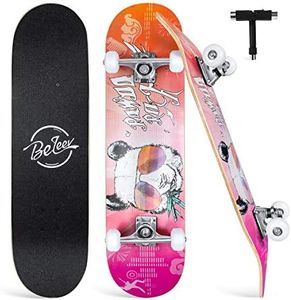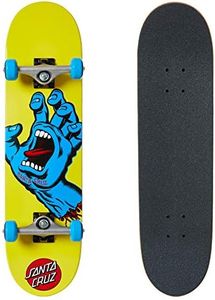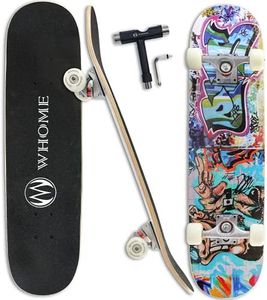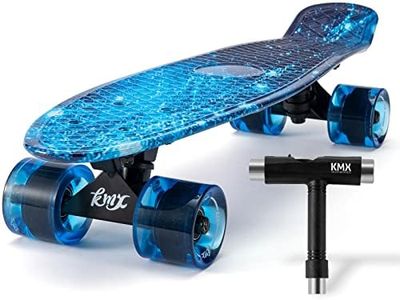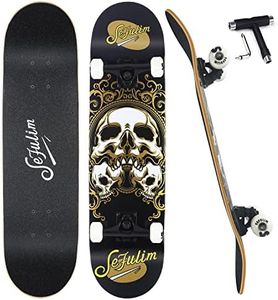We Use CookiesWe use cookies to enhance the security, performance,
functionality and for analytical and promotional activities. By continuing to browse this site you
are agreeing to our privacy policy
10 Best Skateboards For Beginners
From leading brands and best sellers available on the web.Buying Guide for the Best Skateboards For Beginners
Choosing your first skateboard can be exciting, but it’s important to focus on features that make learning easier and safer. As a beginner, you want a board that helps you balance, turn, and stop comfortably. Pay attention to the size, shape, and materials, as these will affect how easy it is to ride and control the skateboard. Think about where you’ll be skating—smooth pavement, skate parks, or rougher streets—and pick a board that matches your environment and style. Remember, the right skateboard will help you build confidence and enjoy the learning process.Deck WidthDeck width refers to how wide the skateboard is from side to side. This is important because a wider deck gives you more stability, which is helpful when you’re just starting out. Decks usually range from about 7.5 inches to 8.5 inches wide. Narrower decks (7.5–8 inches) are lighter and easier to flip, but can feel less stable. Wider decks (8–8.5 inches) offer more room for your feet and are steadier, making them a good choice for beginners who want to feel secure while learning to balance and push. If you have larger feet or want extra stability, go for a wider deck; if you’re smaller or want to try tricks sooner, a narrower deck might suit you.
Deck MaterialMost skateboard decks are made from layers of maple wood, but some use bamboo or composite materials. Maple is popular because it’s strong and flexible, which helps absorb shocks and makes the board last longer. Bamboo is lighter and has a bit more flex, which can feel smoother but may not be as durable. For beginners, a classic maple deck is usually the best choice because it offers a good balance of strength and control, making it easier to learn basic skills.
Deck ShapeThe shape of the deck affects how the skateboard feels under your feet. Most beginner boards have a standard popsicle shape, which is rounded at both ends and works well for general riding and learning tricks. Some boards have a flat or slightly curved nose and tail, which can make it easier to learn to turn and stop. For beginners, a standard shape with a mild concave (the slight curve across the width) is ideal, as it helps keep your feet in place without being too aggressive or hard to control.
Wheel SizeWheel size is measured in millimeters and affects how the skateboard rolls and handles bumps. Smaller wheels (50–54mm) are lighter and better for tricks, but can get stuck on rough surfaces. Larger wheels (55–60mm) roll more smoothly over cracks and pebbles, making them better for beginners who want a comfortable ride. If you plan to skate mostly on smooth surfaces or in skate parks, smaller wheels are fine, but for street or rougher areas, go for larger wheels to make learning easier.
Wheel HardnessWheel hardness, or durometer, tells you how soft or hard the wheels are. Softer wheels (78A–87A) grip the ground better and give a smoother ride, which is great for beginners and rough surfaces. Harder wheels (99A and above) slide more easily and are better for tricks, but can feel bumpy on rough ground. For most beginners, a medium-soft wheel (around 90A–95A) is a good balance, offering comfort and control while you learn.
TrucksTrucks are the metal parts that attach the wheels to the deck and let you turn. The width of the trucks should match the width of your deck for the best balance. Trucks that are too wide or too narrow can make the board harder to control. For beginners, standard trucks that fit the deck width are best, as they provide stable turning and help you learn to balance. You don’t need special or lightweight trucks when starting out—focus on getting the right size for your board.
Grip TapeGrip tape is the rough, sandpaper-like layer on top of the deck that keeps your feet from slipping. Good grip tape is important for safety and control, especially when you’re learning. Most boards come with standard black grip tape, which works well for beginners. Some grip tapes have extra texture or designs, but the main thing is that it provides enough grip to keep you steady while riding and learning new moves.
